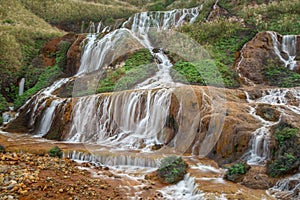Jinguashi (金瓜石) is a quaint mountain town in the Ruifang District, New Taipei City , Taiwan Keelung Mountain
 |
| Arrangement of houses in Jinguashi. The Cyuanji Temple with the Guan gong deity on top is in the top right side |
Gold
Ecological Park
The bus stops right by the
 |
| Entrance to Benshan Tunnel |
The first building on the route is the Japanese ‘Four-Joined’ Style Residence, an old typical Japanese-style Residence from when
Further along the route is the Crown Prince Chalet, another
traditional Japanese style house once occupied by Emperor Hirohito. The
interior of this house is off-limits, but the beautiful garden complete with a small
golf course and archery range is worth seeing.
The Museum
of Gold Gold Museum
The Benshan Fifth Tunnel (本山五坑),
is an abandoned mine next to the Gold Museum
The area outside the Geological Park
Cyuanji
Temple
The
Some of the pagodas offer a wonderful view of the bay below.
You can also see the Ying-yang sea. This
is a strange sight where the sea is a mix
of yellow and blue. It was believed that
the sea color was the result of smelting activities from Taiwan Metal Mining
Corp. But, the company stopped activity there over 10 years ago and the Yin-yang Sea
 |
| Souvenir steel lunchbox from one of the diners at the Geological Park |
After walking around the park, I took a bus down to the Gold
waterfall. The waterfall on the golden earth is one of the sources of the
Ying-yang sea. The heavy rain seeps into
the mine shafts through cracks in the rocks, and reacts with the pyrite and
energite underground, undergoing oxidation reduction to become acidulous water.
It is a spectacular sight. It's best to see it after heavy rains for the full
effect.
 | |
| Gold Waterfall at Jinguashi |
For more information about the Gold Ecological
Park
To see more photos from around Taiwan

No comments:
Post a Comment